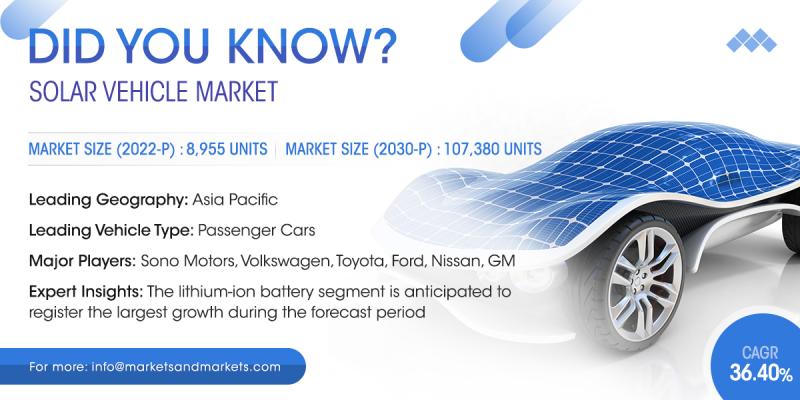A solar vehicle is an electric vehicle integrated with solar panels. Generally, solar panels consist of photovoltaic cells which help to convert solar energy into electric energy. The propulsion of these vehicles is usually offered through solar energy, and the efficiency of solar modules defines the propulsive force of the vehicle.
The Global Solar Vehicle Market is projected to grow at a CAGR of 36.4% during the forecast period to reach 107,380 units by 2030 from an estimated 8,955 units by 2022. The forecast period is from 2022 to 2030.
Factors such as growing concerns over environmental pollution coupled with heavy investments in R&D by automakers would drive the growth of the market globally.
The major market players include Volkswagen (Germany), Toyota (Japan), Ford (US), Mahindra (India), Nissan (Japan), GM (US), Sono Motors (Germany), Cruise Car (US), and Solar Electric Vehicle Company (US), among others.
The lithium-ion battery is the most common and widely accepted by solar vehicle manufacturers globally. The battery is recognized as the best rechargeable battery that provides higher energy density and makes it most suitable for these vehicles. Lithium-ion batteries are largely used in electric vehicles because of their increased power per mass unit. This battery also offers the best charge to weight solution, resulting in increased battery lifecycle. Hence, the lithium-ion battery segment is expected to dominate the market during the forecast period.

Download PDF Brochure @ https://www.marketsandmarkets.com/pdfdownloadNew.asp?id=70646574
The plug-in hybrid electric vehicle (PHEV) is similar to hybrid electric vehicle (HEV) except PHEV batteries can be charged by plugging to an outlet. The PHEV segment is expected to grow at the fastest rate in this market. The demand for electric vehicles is rapidly growing because of increasing environmental pollution and disturbance of ecological balance. This has pushed the growth of the PHEV segment during the forecast period. Integration of solar panels enables the battery of PHEV to be charged through solar rays, thereby eliminating the need of plugging it to an electric outlet. This factor is responsible for the fastest growth of the PHEV segment in the market.
The Asia Pacific region is estimated to be the largest the market by 2030. The region comprises some of the fastest developing economies of the world such as China and India. The Asia Pacific region is the largest market for automotive as the growing purchasing power of consumers has triggered the demand for automobiles in the region. Also, climatic conditions of the Southeast Asian countries are suitable for these vehicles. Moreover, the high demand for passenger cars from emerging countries of the region is likely to drive the growth of the Asia Pacific market during the forecast period.
Europe has been at the forefront in terms of early adoption of electric cars in the world. Thus, it is expected that the adoption of these vehicles in Europe will gain traction during the forecast period. Strict environmental policies and pollution control measures are likely to contribute to the faster adoption of these vehicles in the region. According to a recent report by ING, a leading European financial institution, every new car sold in Europe will be electric in the near future. The integration of solar panels with electric vehicles makes them more efficient, which may lead to higher adoption of these vehicles in the region. Favourable government support, decreasing battery cost, and economies of scale are cited as the primary reason for the stated prediction.
The RoW region is estimated to be the fastest market by 2030. The region comprises some of the developing economies of the world such as Brazil, Dubai, and South Africa. The increasing spending power in countries like Brazil and South Africa among others in the region are contributing to the increasing demand for passenger cars. The rising imbalance of ecology because of excessive emissions by automobiles is generating the need for ecofriendly mobility solutions which will ultimately be responsible for the growth of solar vehicles in the RoW region. Furthermore, the rising electric vehicle sales in the region and their enhanced efficiency by integrating solar panels into it is another factor contributing to the fastest growth of the market in the RoW region.
Request FREE Sample Report @ https://www.marketsandmarkets.com/requestsampleNew.asp?id=70646574
Critical Questions: